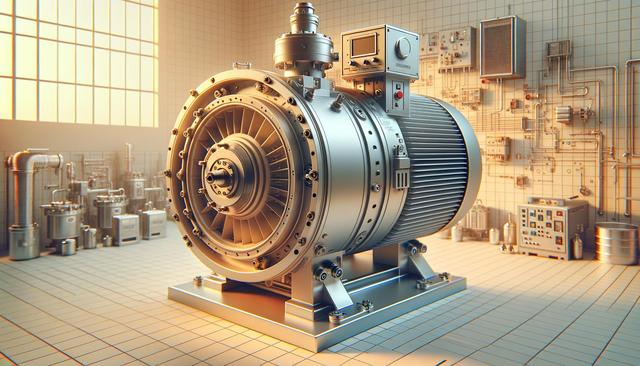Understanding the Rotary High Vacuum Pump
A rotary high vacuum pump is a type of mechanical vacuum pump designed to create a high level of vacuum in a sealed chamber. These pumps operate by using rotating vanes placed inside a cylindrical housing to trap air and gases, which are then expelled to create a vacuum. They are commonly made from robust materials, allowing them to withstand demanding conditions in scientific and industrial use. The primary purpose of these pumps is to remove air molecules from a closed system to achieve a vacuum level suitable for advanced applications. Their compact design, relatively quiet operation, and ability to reach pressures as low as 10-3 mbar make them a preferred choice in many sectors.
Rotary high vacuum pumps are classified into two main types: single-stage and two-stage pumps. Single-stage pumps use one set of vanes and are suitable for applications requiring moderate vacuum levels. In contrast, two-stage pumps include an additional compression stage, allowing them to achieve deeper vacuum levels. This makes them more suitable for high-precision environments like semiconductor manufacturing or vacuum coating processes.
Key Uses in Laboratories and Research
In scientific laboratories, rotary high vacuum pumps are vital tools for a wide range of experiments and processes. These pumps support vacuum filtration, freeze-drying (lyophilization), degassing of solvents, and maintaining controlled environments for sensitive chemical reactions. The ability to maintain a clean and stable vacuum environment is crucial for ensuring the accuracy and repeatability of experiments.
Some common laboratory applications include:
- Vacuum ovens for heat treatment without oxidation
- Mass spectrometry, where low pressure is needed to detect molecular ions
- Rotary evaporation during solvent removal processes
- Glove boxes for handling air-sensitive materials
Rotary high vacuum pumps are also used in academic research institutions and R&D departments of private companies. Their reliability and consistent performance make them an integral part of modern experimental setups.
Applications in Electronics and Semiconductor Industries
The electronics industry relies heavily on high vacuum environments for manufacturing and testing components. Rotary high vacuum pumps are often used in the initial stages of creating a vacuum in systems like deposition chambers, where electronic materials are layered onto substrates. Their ability to quickly evacuate air makes them ideal for creating base vacuum conditions before switching to more advanced high-vacuum systems like turbomolecular pumps.
In semiconductor fabrication, even microscopic contaminants can compromise product quality. Rotary pumps assist in processes such as:
- Thin film deposition for integrated circuits
- Vacuum encapsulation of electronic components
- Leak testing and helium leak detection
- Creating controlled environments for wafer processing
By providing a stable and clean vacuum, these pumps help maintain the high standards required in microelectronics production, ensuring device reliability and performance.
Industrial and Manufacturing Uses
Rotary high vacuum pumps also serve a variety of roles in industrial and manufacturing settings. They are used in metallurgy, vacuum packaging, coating technologies, and the production of electric lamps and tubes. In these environments, the durability and ease of maintenance of rotary pumps are major advantages, especially when systems are running continuously or exposed to aggressive gases.
Key industrial applications include:
- Vacuum casting and molding of metals and plastics
- Thermal processing in vacuum furnaces
- Drying of materials without oxidation or contamination
- Evacuation of large chambers in automation processes
Some industrial processes also benefit from the integration of rotary pumps as backing pumps in complex vacuum systems. Their efficient operation ensures that the entire vacuum chain functions optimally, reducing downtime and enhancing productivity.
Benefits and Operational Advantages
Rotary high vacuum pumps offer several benefits that make them a preferred choice for a wide range of applications. One of the foremost advantages is their ability to provide consistent and reliable vacuum performance. They are also relatively compact, which makes them easy to integrate into existing systems without requiring significant space or infrastructure changes.
Additional benefits include:
- Low maintenance requirements with proper usage
- Cost-effective operation over long periods
- Quiet performance in lab and office settings
- Compatibility with various gases and vapors
To ensure optimal performance, it’s important to maintain the pump properly. This includes regular oil changes, checking for leaks, and ensuring that filters and seals remain in good condition. With proper care, rotary high vacuum pumps can provide years of dependable service, making them a valuable long-term investment for any vacuum-dependent application.
Conclusion: A Versatile Tool for Precision Applications
Rotary high vacuum pumps are indispensable in environments where a stable, clean, and controlled vacuum is essential. Whether used in academic labs, electronics production, or heavy industrial settings, these pumps provide the performance and reliability needed for precision work. Their wide range of applications, from delicate chemical processes to robust manufacturing systems, underscores their versatility. For professionals and organizations seeking dependable vacuum solutions with a manageable footprint and operating cost, rotary high vacuum pumps continue to be a highly valued option.




Leave a Reply